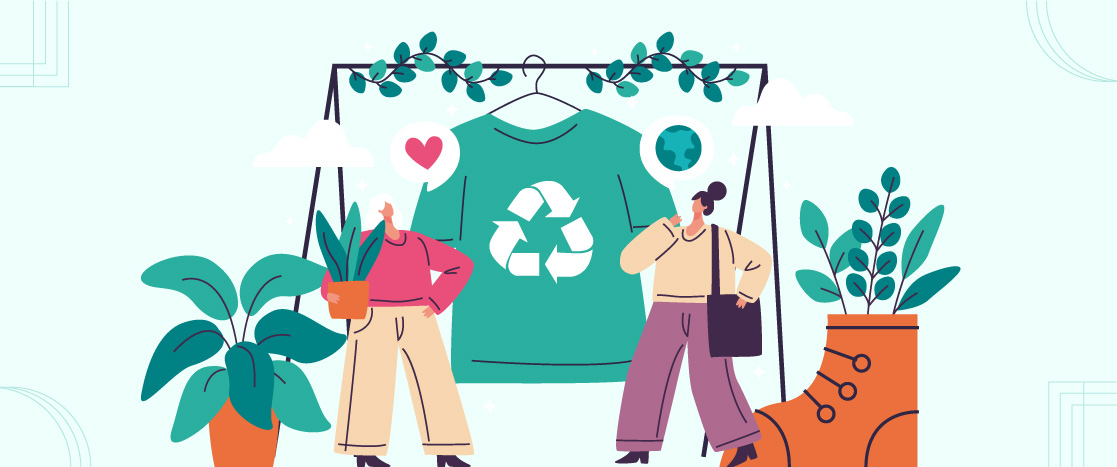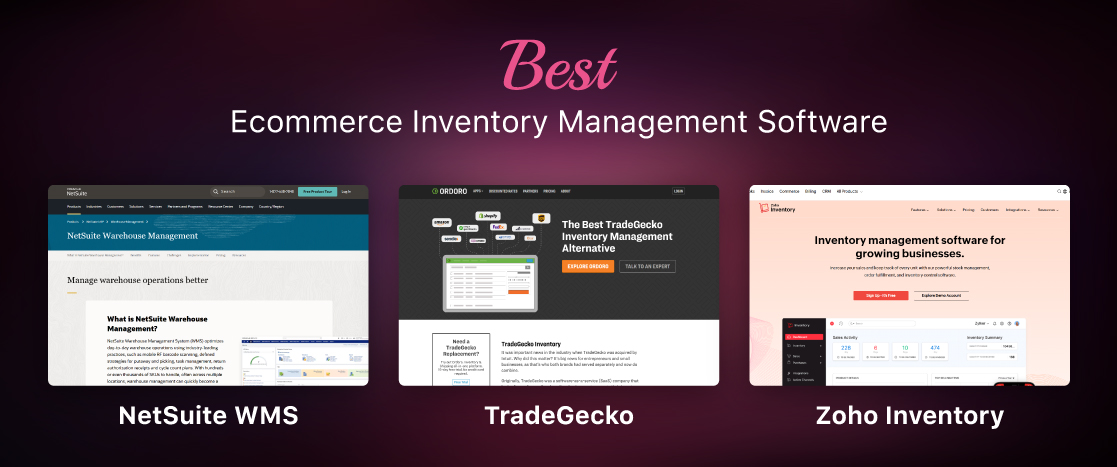
Best Ecommerce Inventory Management Software
- Key Features to Look for in Inventory Management Software
- Integration Capabilities
- Top eCommerce Inventory Management Software Options
- Benefits of Implementing Advanced Inventory Management Systems
- Issues and Factors to Take Into Account When Selecting Inventory Management Software
- Future Trends in eCommerce Inventory Management
- Conclusion
- FAQs
Few things are more discouraging to a buyer than wanting to buy something and discovering that it isn’t available. In addition to missing out on a sale, the company can lose customers’ loyalty to its brand. Knowing what you have on hand, what is selling, and when to place a new order are therefore essential components of a smoothly running firm for an entrepreneur.
Inventory management software handles that task, taking the place of laborious and unreliable analog record-keeping. More information about it, its various varieties, and some suggestions to get you started can be found here. Because of this, having an efficient inventory management system is essential for e-commerce businesses. Inventory templates can be used for this in small businesses, however, ecommerce inventory management software is a better investment for expanding companies. Throughout the whole supply chain, it may assist you in efficiently planning, monitoring, and managing your inventory data.
- Key Features to Look for in Inventory Management Software
- Integration Capabilities
- Top eCommerce Inventory Management Software Options
- Benefits of Implementing Advanced Inventory Management Systems
- Issues and Factors to Take Into Account When Selecting Inventory Management Software
- Future Trends in eCommerce Inventory Management
- Conclusion
- FAQs
How An Inventory Management Software Can Improve Ecommerce Efficiency?
Ecommerce Inventory Management Software encompasses digital tools that help businesses efficiently track, manage, and optimize their inventory across multiple sales channels. These systems are crucial for striking the right balance between supply and demand, ensuring that businesses can fulfill customer orders swiftly while avoiding the pitfalls of overstocking or stockouts.
Effective inventory management is not just about maintaining adequate stock levels; it directly influences customer satisfaction by ensuring products are available when needed, leading to repeat business and brand loyalty.
Additionally, optimized inventory management contributes to significant cost savings by reducing excess stock and minimizing storage costs, which in turn supports overall business growth. In today’s competitive eCommerce environment, robust inventory management software is an indispensable component of a successful strategy, driving efficiency, profitability, and long-term sustainability.

Key Challenges Faced by eCommerce Businesses
Managing inventory in an eCommerce setting presents unique challenges. Unlike brick-and-mortar stores, online retailers must account for multiple sales channels, varying demand patterns, and the complexities of global shipping. Common challenges include:
- Stockouts and Overstocking: Both scenarios can harm profitability and customer satisfaction.
- Inaccurate Inventory Tracking: Without real-time data, businesses may struggle to keep track of stock levels, leading to errors in order fulfillment.
- Integration with Other Systems: Seamlessly connecting inventory management software with eCommerce platforms, ERP, and CRM systems is often difficult but necessary for operational efficiency.
Addressing these challenges requires robust inventory management solutions that offer real-time tracking, automation, and comprehensive analytics.
Key Features to Look for in Inventory Management Software
Businesses may handle orders, automate replenishment, keep track of stock levels, and streamline logistics processes with the use of inventory management software. Real-time tracking, forecasting, barcode scanning, multi-channel integration, and supplier management are some of the essential features.
Order fulfillment, return processing, bespoke reporting, and smooth connection with ERP and accounting systems are also supported. Inventory control becomes more efficient and data-driven with the help of cloud-based access, user role management, and mobile compatibility, which also improve efficiency, scalability, and security.
Real-Time Inventory Tracking
It is a critical feature in modern eCommerce Inventory Management Software, offering businesses up-to-the-minute visibility into their stock levels across all sales channels. This capability allows companies to monitor inventory movements as they happen, providing immediate updates on stock availability, location, and status.
With real-time tracking, businesses can respond quickly to changes in demand, preventing costly issues like stockouts and overstocking. This not only ensures that customers receive accurate information about product availability but also optimizes the supply chain, reducing lead times and enhancing operational efficiency.
A fast and reliable ecommerce hosting platform keeps everything running smoothly, ensuring real-time updates and seamless shopping experiences—so customers always get what they need, when they need it.
Real-time inventory tracking supports more informed decision-making, enabling businesses to adjust their purchasing strategies, manage promotions more effectively, and streamline order fulfillment processes. In the fast-paced world of eCommerce, where consumer expectations for rapid delivery are high, real-time inventory tracking is essential for maintaining a competitive edge and delivering a superior customer experience.

Stockouts and Overstocking Prevention
Real-time inventory tracking is a powerful tool in preventing the costly problems of stockouts and overstocking, both of which can significantly impact a business’s bottom line. Stockouts, where inventory runs out before new stock arrives, can result in missed sales opportunities and frustrated customers who may turn to competitors.
On the other hand, overstocking ties up valuable capital in excess inventory and leads to increased storage costs, potentially causing products to become outdated or obsolete. By providing continuous updates on inventory levels, real-time tracking allows businesses to monitor stock in real time, making it easier to maintain optimal inventory levels.
This ensures that businesses have just the right amount of product on hand to meet customer demand, without overcommitting resources. The ability to adjust quickly based on accurate, up-to-the-minute data helps businesses avoid these pitfalls, ultimately leading to better financial performance and enhanced customer satisfaction.
Automated Reordering
Automated reordering is a key feature in eCommerce inventory management software, providing businesses with a streamlined approach to maintaining optimal stock levels. This functionality enables businesses to set specific reorder points for each product, automatically generating purchase orders when inventory reaches a predetermined threshold. By doing so, it eliminates the need for constant manual monitoring of stock levels, significantly reducing the risk of stockouts, which can lead to lost sales and customer dissatisfaction.
Additionally, automated alerts notify businesses when it’s time to reorder, ensuring that replenishment happens in a timely manner. This proactive approach to inventory management helps maintain continuous product availability, supports smooth operations, and enhances customer satisfaction by preventing disruptions in the supply chain. With automated reordering, businesses can focus more on strategic growth and less on the day-to-day details of inventory management, making it an indispensable tool for efficient and effective eCommerce operations.
Automating the reordering process enables businesses to maintain optimal stock levels with minimal manual intervention, resulting in significant time savings and reduced human error. By leveraging automated systems, businesses can ensure that inventory is replenished precisely when needed, without the constant oversight typically required in manual inventory management.
Integration Capabilities
When selecting eCommerce inventory management software. Effective integration ensures that all business functions are connected, allowing for the smooth and automatic flow of information across different departments. When your inventory management software integrates seamlessly with your eCommerce platform, ERP, and CRM systems, it creates a unified data ecosystem that eliminates the need for repetitive manual data entry, reducing the likelihood of errors and inconsistencies.
This connectivity enables real-time synchronization of inventory levels, orders, customer information, and financial data, enhancing operational efficiency and decision-making. By ensuring that all systems work together harmoniously, businesses can achieve greater accuracy in tracking inventory, forecasting demand, and managing customer relationships.
Examples of Popular Integrations
Common integrations include connections with platforms like Shopify, WooCommerce, Magento, and ERP systems such as SAP and Oracle. CRM integration is also vital, enabling businesses to link customer data with inventory levels, which helps in managing promotions, returns, and customer service more effectively.
Top eCommerce Inventory Management Software Options
Zoho Inventory, TradeGecko (QuickBooks Commerce), and Netsuit are some of the best eCommerce inventory management software choices. These solutions assist companies with inventory synchronization across various sales channels, order fulfillment automation, stock level monitoring, and ERP and accounting system integration.
Effective inventory control is ensured by features including demand forecasting, barcode scanning, real-time tracking, and cloud-based access, which lower overstocking and stockouts. The proper software increases supply chain efficiency overall, optimizes processes, and increases scalability.
NetSuite WMS
NetSuite Warehouse Management System (WMS) is a comprehensive software solution designed to streamline and optimize warehouse operations for eCommerce businesses. It offers a suite of features that help businesses manage their inventory, track product movement, and improve order fulfillment processes.
NetSuite WMS is particularly well-suited for eCommerce businesses that need a robust and scalable solution to manage their inventory and warehouse operations. By automating key processes and providing real-time visibility, NetSuite WMS can help businesses improve efficiency, reduce costs, and enhance customer satisfaction.
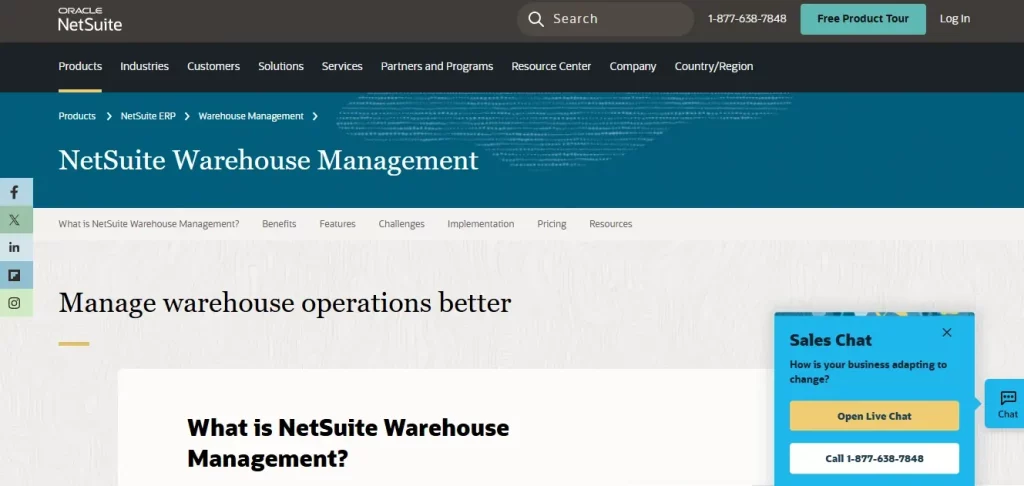
Features:
- NetSuite Warehouse Management System (WMS) is a sophisticated solution tailored for eCommerce businesses seeking comprehensive inventory management.
- Its key features include real-time inventory tracking, which ensures accurate stock level updates across all sales channels, minimizing discrepancies and optimizing inventory control.
- The software also offers automated reordering, allowing businesses to set reorder points and automatically generate purchase orders when stock falls below these thresholds.
- Multi-channel integration is another crucial feature, enabling seamless connectivity with various eCommerce platforms and ERP systems to unify data and streamline operations.
- The intuitive interface and customizable dashboards enhance usability, making it suitable for businesses of various sizes, from small startups to large enterprises.
Benefits:
- NetSuite WMS provides significant advantages, including reduced risk of stockouts and overstocking through real-time tracking and automated reordering.
- This ensures optimal inventory levels and improves order fulfillment accuracy.
- The multi-channel integration supports efficient data management and enhances operational coordination.
- The user-friendly interface and customizable dashboards boost operational efficiency, saving time and reducing errors.
- Overall, NetSuite WMS enhances warehouse management, supports business growth, and improves customer satisfaction by providing a comprehensive and scalable solution.
TradeGecko
TradeGecko is a cloud-based inventory management system specifically designed for eCommerce businesses. It offers a comprehensive set of features to help businesses effectively track, manage, and optimize their inventory across multiple sales channels.
TradeGecko is a popular choice for eCommerce businesses of all sizes, as it provides a user-friendly interface and powerful features to streamline inventory management processes. Its ability to integrate with various sales channels and provide real-time data makes it a valuable tool for businesses looking to improve efficiency and grow their sales.
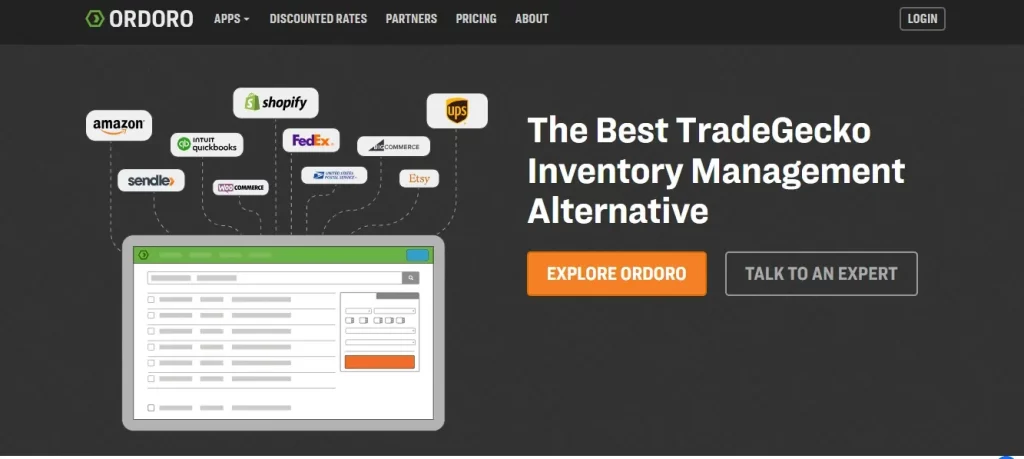
Features:
- TradeGecko is renowned for its advanced analytics and reporting capabilities.
- The software provides in-depth insights into inventory trends, helping businesses optimize stock levels and reduce carrying costs.
- TradeGecko also supports seamless integration with major eCommerce platforms and ERP systems, ensuring smooth data synchronization and streamlined operations.
- Key features include real-time inventory tracking, automated reordering, and robust reporting tools that offer detailed analytics and forecasting.
Benefits:
- TradeGecko’s advanced analytics enable businesses to make data-driven decisions, reducing carrying costs and improving stock management.
- Seamless integration with eCommerce platforms and ERP systems fosters efficient data management and operational coordination.
- The real-time tracking and automated reordering features enhance inventory accuracy and order fulfillment.
- This software is ideal for larger eCommerce enterprises that need sophisticated tools to manage high stock volumes and complex supply chains, ultimately supporting operational efficiency and growth.
Zoho Inventory
Zoho Inventory is a cloud-based inventory management software designed to help businesses efficiently track, manage, and optimize their inventory across multiple sales channels. It offers a comprehensive set of features to streamline inventory processes and improve overall efficiency.
Zoho Inventory is a popular choice for businesses of all sizes, as it provides a user-friendly interface and powerful features to streamline inventory management processes. Its ability to integrate with various sales channels and provide real-time data makes it a valuable tool for businesses looking to improve efficiency and grow their sales.
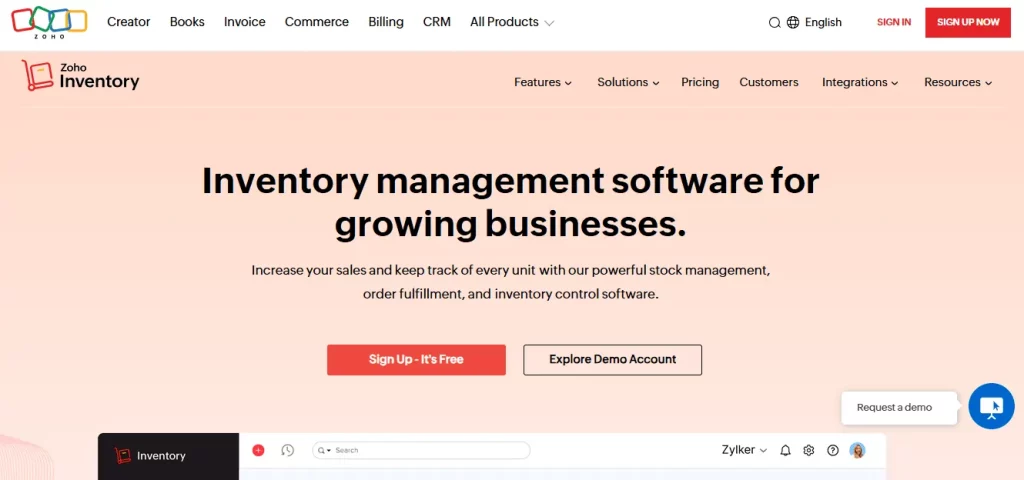
Features:
- Zoho Inventory is a cloud-based solution designed for ease of use and accessibility.
- It includes features such as automated reordering, real-time inventory tracking, and integration with popular eCommerce platforms.
- The software’s mobile app allows users to manage inventory on the go, making it highly convenient for businesses with remote or mobile operations.
Benefits:
- Zoho Inventory offers significant benefits, including simplified inventory management through automated reordering and real-time tracking.
- The integration with eCommerce platforms ensures seamless data flow and operational efficiency.
- The mobile app enhances accessibility and flexibility, allowing businesses to manage their inventory from anywhere.
- This makes Zoho Inventory particularly appealing to small eCommerce businesses and startups that need an affordable and user-friendly inventory management solution.
Benefits of Implementing Advanced Inventory Management Systems
Advanced eCommerce inventory software streamlines inventory processes, reducing manual labor and minimizing errors. Automated features such as real-time tracking and reordering free up valuable time, allowing staff to focus on other critical tasks. This increased efficiency leads to higher productivity and improved operational performance.
Improved Customer Satisfaction
Effective inventory management directly impacts customer satisfaction by ensuring that products are always in stock and orders are fulfilled accurately and promptly. With real-time inventory updates, customers receive accurate information about product availability, leading to a better shopping experience and increased customer loyalty.
Cost Savings and ROI
Implementing the best eCommerce inventory management software can lead to significant cost savings by reducing excess inventory, minimizing stockouts, and optimizing storage costs. The return on investment (ROI) is often realized through improved cash flow, reduced waste, and increased sales due to better inventory availability.
Issues and Factors to Take Into Account When Selecting Inventory Management Software
Think about things like cost, scalability, convenience of use, and integration difficulties while choosing inventory management software. Real-time tracking, multi-channel interoperability, automation functionality, and reporting capabilities are important considerations. Complex implementation, little room for customization, and a lack of assistance for company expansion could all be potential issues.
Additionally important are security, mobile accessibility, supply chain, accounting, and ERP system integration. Selecting the appropriate software guarantees effective inventory management lowers errors, and improves overall company operations.
Scalability Issues
Scalability is a critical factor when selecting inventory management software. As eCommerce businesses grow, their inventory management needs will evolve. It’s essential to choose software that can scale with the business, supporting increased inventory volumes, additional sales channels, and more complex operations.
Customization and Flexibility
Every eCommerce business has unique inventory management needs. Therefore, the ability to customize the software to fit specific requirements is crucial. Look for solutions that offer flexible features and integration options, allowing the software to adapt to your business processes rather than forcing your business to adapt to the software.
Data Security and Compliance
With the increasing reliance on digital tools, data security is a top concern for eCommerce businesses. Ensure that the inventory management software for small business you choose complies with industry regulations and offers robust security features to protect sensitive data. This includes encryption, secure access controls, and regular software updates.
Future Trends in eCommerce Inventory Management
The integration of AI and machine learning in inventory management is revolutionizing the way businesses manage their stock. These technologies enable predictive analytics, allowing businesses to forecast demand more accurately and optimize inventory levels. AI-driven automation also enhances decision-making, reducing the need for manual intervention in routine tasks.
Ecommerce software with inventory management will focus on providing seamless omni-channel capabilities, ensuring that inventory is synchronized across all platforms and that customers receive a consistent experience, regardless of the sales channel.
Conclusion
In today’s competitive eCommerce landscape, effective inventory management is crucial for success. Ecommerce Inventory Management Software offers the tools and features necessary to streamline inventory processes, improve efficiency, and enhance customer satisfaction.
When choosing the best inventory management software for your business, consider factors such as real-time tracking, automated reordering, integration capabilities, and scalability. By selecting a solution that aligns with your business needs, you can optimize inventory management, reduce costs, and drive growth.
This comprehensive guide should help you navigate the complexities of eCommerce inventory management and select the right software to support your business’s success in 2024 and beyond.
FAQs
What does the inventory management system cost?
The cost of an inventory management system (IMS) is affected by several variables, including the number of users, the functionality needed, and whether the system is locally hosted or cloud-based. Data migration, training, and setup are additional expenses.
What is SKU in ecommerce?
Vendors can track inventory with the use of a scannable code called a stock-keeping unit (SKU). SKUs frequently have alphanumeric digits and bar or QR codes. SKUs are also utilized for warranties, services, and maintenance units.





